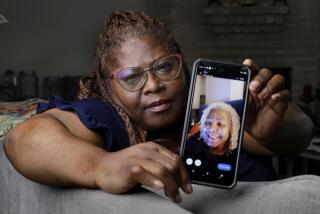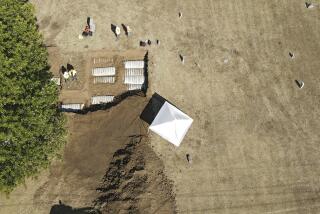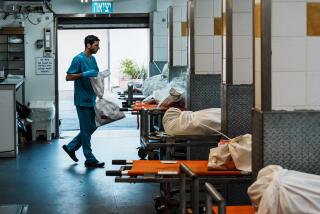Katrina’s Corpses Are Many, IDs Are Few
BATON ROUGE, La. — A month after Hurricane Katrina ravaged the Louisiana coast, coroners have positively identified just 32 of the nearly 800 corpses collected at a temporary morgue, officials said Wednesday.
Only about a third of the recovered bodies have been even tentatively identified, underscoring the difficulty of confirming the identities and causes of death for victims of a disaster that left corpses decomposing in floodwaters and scattered survivors across the country.
In the first public accounting of the dead, the state’s chief medical examiner acknowledged that some victims may never be identified. For many others, he said, the date and cause of death may never be known.
“These are horrible times,” Dr. Louis Cataldie, the medical examiner in charge of the effort, told reporters. “It’s extremely frustrating. I wish I could speed up the process. But speeding up the process could contaminate the process, and I just can’t do that.”
Forensic experts said the effort had been compromised by the scale of flooding over hundreds of square miles, the destruction of medical and dental records, the loss of physical evidence and the deterioration of corpses in contaminated water and subtropical heat and humidity. Many victims lived in low-income areas with poor or haphazard medical and dental care.
“It’s a much more difficult and time-consuming process than it would be under normal conditions,” said Terry Edwards, a Texas funeral director serving as operations chief of the temporary morgue in St. Gabriel, La., where 783 bodies have been examined and stored in freezer trailers.
National forensic experts not involved in the Louisiana investigation said decomposition alone would make identification and determining the time and cause of death extremely difficult. Many corpses were left to decay for days, and in some cases more than a week, as emergency crews focused on rescuing survivors.
“After a while, all the bodies will look the same,” said Dr. Werner Spitz, a forensic pathologist and coauthor of “Medicolegal Investigation of Death,” considered by many experts the preeminent textbook of the field.
The best understanding of how Katrina killed so many people will probably have to come from witness accounts and family recollections, not modern science, these experts said. And locating family members, many of whom have been evacuated to other states, will be complex and time-consuming.
“Forget about what you see on ‘CSI,’ ” said James Starrs, a professor of forensic science at George Washington University Law School, referring to the TV drama in which forensic investigators use high-tech tools to solve virtually every crime before them.
In addition to 896 Katrina deaths reported in Louisiana, 220 people died in Mississippi and 19 in four other states.
Both Cataldie and Dr. Frank Minyard, the coroner of Orleans Parish -- where officials believe most of the Katrina deaths took place -- said the date of death for most victims would be registered as Aug. 29, the day the hurricane made landfall. That is a departure from procedure in a profession in which precision is normally paramount.
“It could give the false impression that they all died as a result of the storm -- and that whatever actions or mistakes were made by local, federal and state authorities didn’t contribute to the deaths,” said Dr. Michael Baden, former chief medical examiner for New York state.
Minyard said gunshot wounds had been found in seven bodies, and a woman appeared to have been strangled with an extension cord. But distinguishing homicides and suicides would be difficult, he added.
Cataldie said about 100 autopsies had been performed, either in cases of suspected homicides or as part of a state investigation into operators of nursing homes and hospitals charged with or suspected of abandoning elderly patients.
Ten corpses were recovered from the Louisiana Superdome and four from the city’s convention center, all of them adults, Cataldie said. But contrary to published reports of murders inside those facilities, he said, none of the cases involved homicide.
Cataldie declined to provide information on the race and age of Katrina victims, where their corpses were recovered or their likely causes of death. He said the information was being entered into a database being compiled at the temporary morgue.
“There have been some children recovered, but thank God there haven’t been that many,” he said.
One of the victims identified Wednesday, Alma Ryburn, 83, had been suffering from Alzheimer’s disease and died after being evacuated from her Metairie hospice to St. Charles Hospital in New Orleans, and then to a hospital in Lafayette, said her son, Wayne Dean Ryburn.
As Katrina neared, Wayne Ryburn had been increasingly worried about his mother, who weighed less than 70 pounds and was disoriented. “I told my sister, ‘I don’t know if she can go through this,’ ” he said.
He described his mother as an “old-fashioned” Cajun woman who never held a job or driver’s license but volunteered in her church and local schools.
Cataldie said he expected more bodies to be recovered in the Lower 9th Ward of New Orleans and in St. Bernard and Plaquemines parishes. He said he was concerned that people returning to their homes would stumble across bodies; at least one returning evacuee has done so, he said.
Of the 340 corpses that Louisiana officials have tentatively identified, most were recovered from hospitals and nursing homes. Many wore medical bracelets, speeding identification. Almost all of the 32 victims identified by state officials were found in nursing homes or hospitals, Cataldie said.
In most of those cases, he said, preexisting medical conditions contributed to the deaths during the trauma of trying to survive the storm and flooding.
But for hundreds of other victims, coroners do not yet know how or when most of them died, Cataldie said. With 10 bodies recovered Tuesday, officials said, the number of flood victims in the state Wednesday was 896. Just more than 100 bodies were turned over to local coroners and are not included in the tally at the temporary morgue.
The state has set up a hotline for survivors to report missing relatives. Investigators will try to collect DNA evidence from family members and try to match it to samples taken from bodies at the morgue, Cataldie said.
“DNA is only as good as the match we can make with the individual [corpse],” he said.
Under normal circumstances, medical examiners or their staff members visit death scenes to gather evidence essential to determining the cause, timing and manner of death. But the hurricane and flooding erased that.
Kenyon International Emergency Services Inc., the Houston company contracted to recover bodies, labels each with an address and description of where it was found.
But many corpses were carried for blocks by floodwaters or tied to the nearest tree or fence by rescue crews.
After all avenues are exhausted without positive identification, Cataldie said, the state will wait a month or two before burying unidentified corpses at a local cemetery. He said a chapel and memorial would be provided.
“I think we’re all going to need some healing,” he said.
Times researcher Nona Yates contributed to this report.
More to Read
Sign up for Essential California
The most important California stories and recommendations in your inbox every morning.
You may occasionally receive promotional content from the Los Angeles Times.












